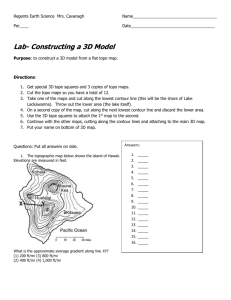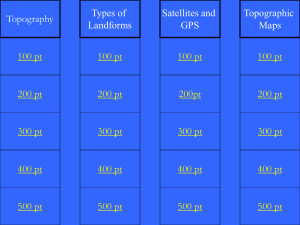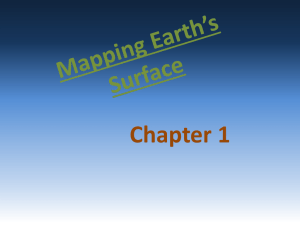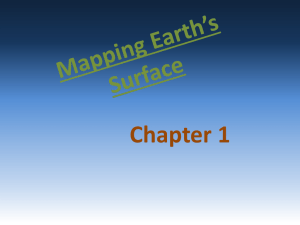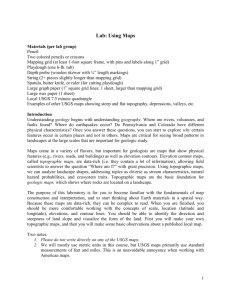970 - Cloudfront.net
advertisement
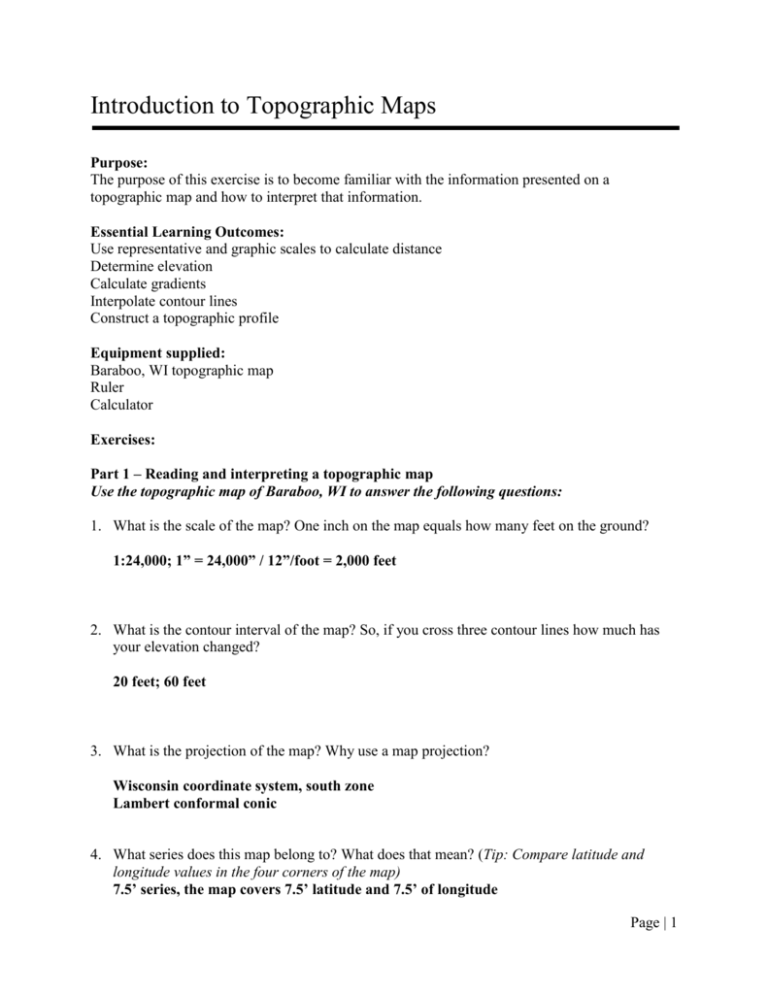
Introduction to Topographic Maps Purpose: The purpose of this exercise is to become familiar with the information presented on a topographic map and how to interpret that information. Essential Learning Outcomes: Use representative and graphic scales to calculate distance Determine elevation Calculate gradients Interpolate contour lines Construct a topographic profile Equipment supplied: Baraboo, WI topographic map Ruler Calculator Exercises: Part 1 – Reading and interpreting a topographic map Use the topographic map of Baraboo, WI to answer the following questions: 1. What is the scale of the map? One inch on the map equals how many feet on the ground? 1:24,000; 1” = 24,000” / 12”/foot = 2,000 feet 2. What is the contour interval of the map? So, if you cross three contour lines how much has your elevation changed? 20 feet; 60 feet 3. What is the projection of the map? Why use a map projection? Wisconsin coordinate system, south zone Lambert conformal conic 4. What series does this map belong to? What does that mean? (Tip: Compare latitude and longitude values in the four corners of the map) 7.5’ series, the map covers 7.5’ latitude and 7.5’ of longitude Page | 1 5. Fill in the information below: A. Highest point on map (name and elevation): Sauk Point; 1593 ft above sea level B. Lowest point on map (name and elevation): Gallus Slough; 774 ft above sea level C. Total relief of map (A – B): 1593 ft – 774 ft = 819 ft 6. Which gradient is steeper, the west bluff or the east bluff of Devils Lake? How can you tell? West bluff; the contour lines are closer together 7. Is the Baraboo River flowing from west to east or from east to west? How can you tell? West to east; the contour lines indicate a higher elevation to the west and water flows from higher elevations to lower elevations 8. Using the graphic scale, determine the straight-line distance in miles between Brewster Cemetery and Koerth Cemetery. ~1.95 miles 9. Using the representative scale, determine the straight-line distance in miles between Brewster Cemetery and Koerth Cemetery. How does your answer compare to question 8? Which do you think is more accurate? 5.125” x 24,000” = 123,000” / 12”/foot = 10,250 ft / 5,280 ft/mile = 1.94; my answer is slightly less than answer 8; I think using the representative scale is more accurate because you only estimate distance once and then use mathematics 10. Which ski lift for Devils Head Lodge (found on the right side of the map) has the steepest gradient? Ski Lift Top elev. Bottom “Rise” Distance on “Run” Gradient elev. map 1 (west) 1,280 ft 945 ft 335 ft 0.875” 1,750 ft 19% 2 1,370 ft 940 ft 430 ft 1.375” 2.,750 ft 15.6% 3 (center) 1,380 ft 940 ft 440 ft 1.375” 2,750 ft 16% 4 1,410 ft 930 ft 480 ft 1.3125” 2,625 ft 18.1% 5 (east) 1,410 ft 950 ft 460 ft 1.1875” 2,375 ft 18.9% Page | 2 Part 2 – Constructing a topographic profile A topographic profile is a cross-section view of the topography of a landscape along a transect. Use the Baraboo, WI topographic map and the profile grid below to construct a topographic profile along the thin black line that passes west to east through Devils Lake, originating at 4811 on the west side of the map and ending at the 1300 ft index contour immediately west of the red line in section 19. To construct the profile, fold this paper so that the top of the profile grid forms the top edge of this sheet of paper. Determine the interval and label the lines of the Y-axis; the base line should be slightly less than the minimum elevation along the transect, the top line should be slightly greater than the maximum elevation along the transect, and each interval line in between should be equally-spaced. For example, if the minimum elevation is 424 ft and the maximum elevation is 697 ft, you should use base and top line values of 420 ft and 700 ft. This is a difference of 280 ft; since there are 14 interval lines, the interval between lines is 20 ft (280 ft / 14 = 20 ft). Next, place the left side of the profile grid on the western edge of the map at point 4811 and align the top edge of the profile grid with the thin black line. Project points along the thin black line straight down to the interval line of equal value on the profile grid and place a dot at that spot on the grid. Plot beginning and end points and points at each location that the thin black line crosses an index contour (the dark brown lines). Connect all of the dots, interpolating between high and low points, to complete the topographic profile. 1500’ 1380’ 1300’ 1180’ 1100’ 1020’ 940’ Page | 3 Part 3 – Drawing contour lines In the diagram below, dashed lines represent stream channels and black dots with numbers represent elevation points in feet above sea level. The 950 ft contour line has been provided. Draw all other contour lines for the elevation data using a 10-ft contour interval. Label each end of the contour line appropriately. To plot contour lines between two points you must interpolate its position; that is, you must decide where best to draw it based on nearby data points (i.e., the 980 ft line should be drawn closer to the 982 ft data point than the 971 ft data point). 980’ 971 970’ 981 977 982 984 980’ 977 970 975 967 970’ 963 971 961 968 962 964 960 960 956 960’ 960’ 960 959 958 956 953 954 950 951 948 950 949 946 950’ 950’ Page | 4



